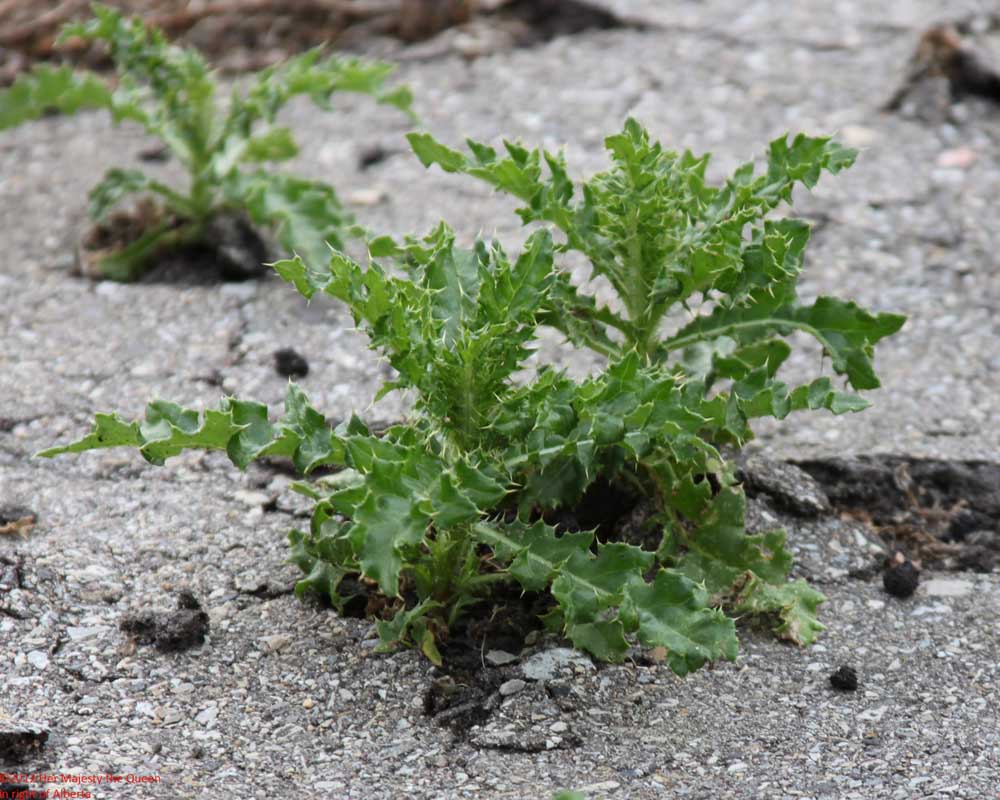Weed Of The Week #13 - Creeping Thistle AKA Canada Thistle (Cirsium arvense)

Noxious Under Alberta's Weed Control Act
Submitted By Kelly Cooley, CoolPro Solutions
Most people are aware of Creeping Thistle (most often called Canada Thistle), but how well do you really know this long-established creeping-rooted perennial that infests nearly 10 million square kilometers within North America? For starters, the species did not originate from Canada – it is native to southeast Europe and the eastern Mediterranean region. There has been an active campaign (mostly by Canadian invasive species professionals) to replace the inappropriate common name of this species with Creeping Thistle, which is much more descriptive of the way this invader reproduces and spreads.
Creeping Thistle mainly spreads via its extensive creeping root system, which generates above ground shoots from buds along these roots that can grow to 6 and 15 feet (2 to 4.5 metres) deep with depths of 18 feet (5.5 metres) reported. Even a half-inch section of root with one or more viable stem buds can reproduce an entirely new colony of thistle in a single season. Germinating seeds and vegetative root shoots that emerge in mid to late spring send up erect stems that may (or may not) form flowering buds, usually by early to mid-July. Each stem can produce 1,000 – 5,000 seeds, which are readily spread by wind, water, birds, mammals, feed, fodder, and manure. Fertile seeds may germinate soon after dispersal within a year, or stay viable for between 3 and 20 years, depending on depth of burial.
Creeping Thistle shoots that form in late summer to fall do not produce flowering stems that year, but remain rosettes that photosynthesize and nourish the roots until killing frost causes top leafy growth to die back. These roots absorb water and nutrients from the soil and sugars from photosynthesizing leaves, store carbohydrate reserves, and can regenerate above ground stems and leaves. Carbohydrate levels in the roots are lowest in the latter part of June (after extensive stem elongation is complete and flowers are forming). In the fall, carbohydrates within the root system are converted to sugar which prevents the formation of damaging ice crystals, shielding roots from winter frost damage and fueling regeneration from these roots the following spring.
Creeping Thistle is highly adaptable, first invading disturbed sites in or near roadsides, gardens, pastures, stream banks, pond or lake banks, forest edges or openings, and cropland. As root systems establish and spread, it may spread to less disturbed areas. It prefers full sun to shade, and grows in most soil types.
Mowing Creeping Thistle can only be effective if repeatedly conducted over the season and combined with timely and appropriate herbicide application in the fall. Alberta research showed one-time mowing actually stimulated more Canada Thistle shoots to emerge from the roots. Mowing Canada thistle beginning in late June and repeating in July when root reserves are low may result in greatest reduction of growth above ground forcing roots to send up rosettes in August to replenish root reserves – but mowing alone will not control it effectively. Mowing as described allows herbicide application on autumn regrowth prior to killing frost. Herbicide translocates better into the root system at this time for the reasons outlined in the description above, further weakening roots prior to winter. No effective biological control agents have achieved widespread control, though many are being researched. Livestock may also be trained to feed on Creeping Thistle, but consult with someone experienced in this approach before attempting control in this manner.
More information on this aggressive invader can be found in the Canada Thistle fact sheet from the Alberta Invasive Species Council, and you can report this invader yourself using their free EDDMapS application on your mobile device. For local Creeping Thistle control options, particularly herbicide choices, please contact our Agricultural Fieldman at 403-339-8741.
Photo Credits:
Kelly Cooley, CoolPro Solutions
Nicole Kimmel, Alberta Environment & Parks – From Alberta Invasive Species Council Website
Return to News & Events



